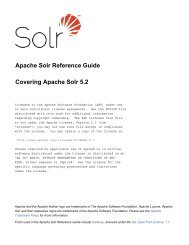Create successful ePaper yourself
Turn your PDF publications into a flip-book with our unique Google optimized e-Paper software.
10<br />
7<br />
6<br />
5<br />
4<br />
3<br />
2<br />
1<br />
Parity check capacity CPC<br />
7<br />
6<br />
5<br />
4<br />
3<br />
2<br />
1<br />
ESN100<br />
ESN50<br />
ESN10<br />
0<br />
0<br />
0 5 10<br />
0<br />
15<br />
5<br />
20<br />
10<br />
25<br />
15<br />
30<br />
20 25 30<br />
Short term memory capacity CSTM<br />
(b)<br />
x’i (t )<br />
x’i (t )<br />
1<br />
0.8<br />
0.6<br />
0.4<br />
0.2<br />
0<br />
fully-connected transverse Ising QR (non-integrable system)<br />
Parity check capacity CPC<br />
7<br />
7<br />
N=6<br />
7<br />
N=6 N=7<br />
6 (c)<br />
N=7 N=6 N=5<br />
6<br />
N=5 N=7 N=4<br />
6<br />
N=4 N=5 N=3<br />
5<br />
N=3 N=4 N=2<br />
5<br />
N=2 N=3<br />
5<br />
N=2<br />
4<br />
ESN500<br />
4<br />
ESN300<br />
4<br />
ESN200<br />
3<br />
ESN100<br />
3<br />
3<br />
SR~1<br />
2<br />
2<br />
ESN50<br />
2<br />
1<br />
1<br />
ESN10<br />
1<br />
0<br />
0 0 5 10 15 20 25 30<br />
0 0 5 10 15 20 25 30<br />
0 5 10 15 20 25<br />
Short term memory capacity CSTM<br />
30<br />
4000 4050 4100 4150 4200<br />
1D transverse Ising QR (integrable system)<br />
time tΔ<br />
1<br />
0.8<br />
0.6<br />
0.4<br />
0.2<br />
0<br />
(a)<br />
ESN200<br />
N=6<br />
N=7<br />
N=5<br />
N=4<br />
N=3<br />
N=2<br />
ESN300<br />
10<br />
ESN500<br />
7<br />
6<br />
5<br />
5<br />
4<br />
0<br />
128 τΔ<br />
SR~1<br />
3<br />
2<br />
-5<br />
integrable systems<br />
1<br />
-10<br />
0.125<br />
0<br />
0 5 10 15 20 25 30<br />
4000 4050 4100 4150 4200<br />
time tΔ<br />
qubit 1 qubit 2 qubit 3 qubit 4 qubit 5 purity input<br />
FIG. 7. STM and PC capacities under various settings. (a) Capacities for the 5-qubit QRs plotted with various parameters<br />
τ∆ = 0.125–128, J/∆ = 0.05–1.0, h/∆ = 0.5, and V = 1–50. Integrable cases with 1DNN couplings are shown as “integrable<br />
systems”. For each setting, the capacities are evaluated as an average on 20 samples, and the standard deviations are shown by<br />
the error bars. (b) Typical dynamics with fully connected (upper) and 1DNN couplings (lower) are shown with the signals from<br />
each qubit. The input sequence and purity, a measure of quantum coherence, are shown by dotted and solid lines, respectively.<br />
(c) QRs with J/∆ = 2h/∆ = 1 and 0.125 ≤ τ∆ ≤ 128 for N = 2–7. For each setting, the capacities are evaluated as an average<br />
on 20 samples, and the standard deviations are shown by the error bars. The ESNs with 10–500 nodes are shown as references.<br />
In Fig. 7 (c), the STM and PC capacities are plotted<br />
for the QRs from N = 2 to N = 7. The 7-qubit QRs, for<br />
example, with τ∆ = 2, J/∆ = 2h/∆ = 1, and V = 10–<br />
50, are as powerful as the ESNs of 500 nodes with the<br />
spectral radius around 1.0. Note that even if the virtual<br />
nodes are included, the total number of nodes NV = 350<br />
is less than 500.<br />
B. Robustness against imperfections<br />
We here investigate the effect of decoherence (noise) to<br />
validate the feasibility of QRC. We consider two types of<br />
noise: the first is decoherence, which is introduced by an<br />
undesired coupling of QRs with the environment, thereby<br />
resulting in a loss of quantum coherence, and the other is<br />
a statistical error on the observed signals from QRs. The<br />
former is more serious because quantum coherence is, in<br />
general, fragile against decoherence, which is the most<br />
difficult barrier for realizations of quantum information<br />
processing.<br />
We employ the dephasing noise as decoherence, which<br />
is a simple yet experimentally dominant source of noise.<br />
In the numerical simulation, the time evolution is divided<br />
into a small discrete interval δt, and qubits are exposed to<br />
the single-qubit phase-flip channel with probability (1 −<br />
e −2γδt )/2 for each timestep:<br />
E(ρ) = 1 + e−2γδt<br />
ρ + 1 − e−2γδt<br />
ZρZ. (19)<br />
2<br />
2<br />
This corresponds to a Markovian dephasing with a de-



